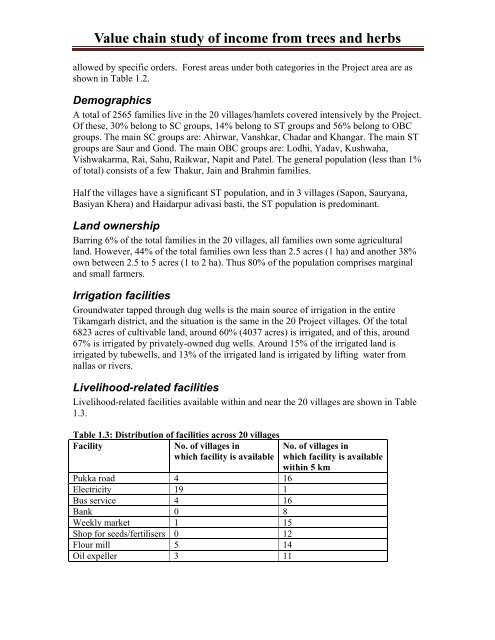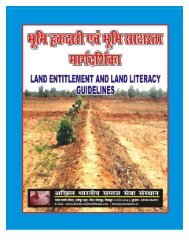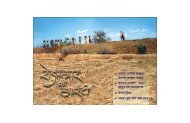Value chain study of income from trees and herbs - ABSSS
Value chain study of income from trees and herbs - ABSSS
Value chain study of income from trees and herbs - ABSSS
Create successful ePaper yourself
Turn your PDF publications into a flip-book with our unique Google optimized e-Paper software.
<strong>Value</strong> <strong>chain</strong> <strong>study</strong> <strong>of</strong> <strong>income</strong> <strong>from</strong> <strong>trees</strong> <strong>and</strong> <strong>herbs</strong><br />
allowed by specific orders. Forest areas under both categories in the Project area are as<br />
shown in Table 1.2.<br />
Demographics<br />
A total <strong>of</strong> 2565 families live in the 20 villages/hamlets covered intensively by the Project.<br />
Of these, 30% belong to SC groups, 14% belong to ST groups <strong>and</strong> 56% belong to OBC<br />
groups. The main SC groups are: Ahirwar, Vanshkar, Chadar <strong>and</strong> Khangar. The main ST<br />
groups are Saur <strong>and</strong> Gond. The main OBC groups are: Lodhi, Yadav, Kushwaha,<br />
Vishwakarma, Rai, Sahu, Raikwar, Napit <strong>and</strong> Patel. The general population (less than 1%<br />
<strong>of</strong> total) consists <strong>of</strong> a few Thakur, Jain <strong>and</strong> Brahmin families.<br />
Half the villages have a significant ST population, <strong>and</strong> in 3 villages (Sapon, Sauryana,<br />
Basiyan Khera) <strong>and</strong> Haidarpur adivasi basti, the ST population is predominant.<br />
L<strong>and</strong> ownership<br />
Barring 6% <strong>of</strong> the total families in the 20 villages, all families own some agricultural<br />
l<strong>and</strong>. However, 44% <strong>of</strong> the total families own less than 2.5 acres (1 ha) <strong>and</strong> another 38%<br />
own between 2.5 to 5 acres (1 to 2 ha). Thus 80% <strong>of</strong> the population comprises marginal<br />
<strong>and</strong> small farmers.<br />
Irrigation facilities<br />
Groundwater tapped through dug wells is the main source <strong>of</strong> irrigation in the entire<br />
Tikamgarh district, <strong>and</strong> the situation is the same in the 20 Project villages. Of the total<br />
6823 acres <strong>of</strong> cultivable l<strong>and</strong>, around 60% (4037 acres) is irrigated, <strong>and</strong> <strong>of</strong> this, around<br />
67% is irrigated by privately-owned dug wells. Around 15% <strong>of</strong> the irrigated l<strong>and</strong> is<br />
irrigated by tubewells, <strong>and</strong> 13% <strong>of</strong> the irrigated l<strong>and</strong> is irrigated by lifting water <strong>from</strong><br />
nallas or rivers.<br />
Livelihood-related facilities<br />
Livelihood-related facilities available within <strong>and</strong> near the 20 villages are shown in Table<br />
1.3.<br />
Table 1.3: Distribution <strong>of</strong> facilities across 20 villages<br />
Facility<br />
No. <strong>of</strong> villages in<br />
which facility is available<br />
Pukka road 4 16<br />
Electricity 19 1<br />
Bus service 4 16<br />
Bank 0 8<br />
Weekly market 1 15<br />
Shop for seeds/fertilisers 0 12<br />
Flour mill 5 14<br />
Oil expeller 3 11<br />
No. <strong>of</strong> villages in<br />
which facility is available<br />
within 5 km






